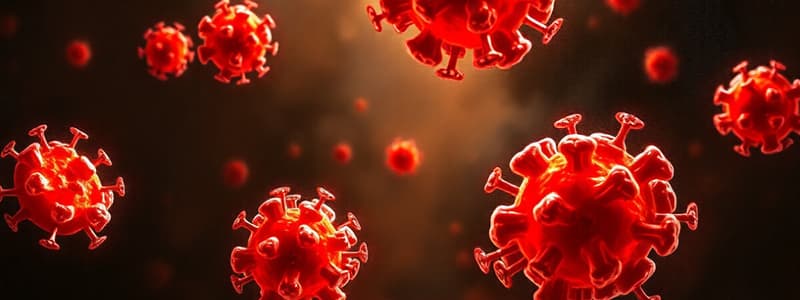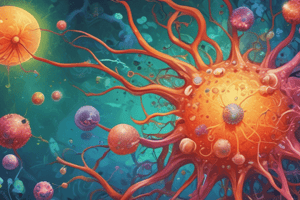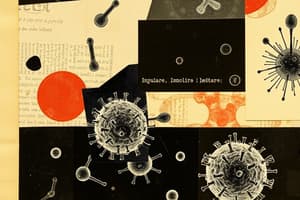Podcast
Questions and Answers
What is the primary characteristic of monoclonal antibodies?
What is the primary characteristic of monoclonal antibodies?
- Produced by a single clone of B-cell (correct)
- Have diverse antigenic specificities
- Only used for research purposes
- Produced by multiple clones of B-cells
Which immunoglobulin type has the most binding sites?
Which immunoglobulin type has the most binding sites?
- IgG
- IgA
- IgE
- IgM (correct)
What mechanism allows B cells to produce antibodies of different heavy-chain classes?
What mechanism allows B cells to produce antibodies of different heavy-chain classes?
- Clonal expression
- Class switching (correct)
- Clonal selection
- Affinity maturation
How do dendritic cells activate T cells?
How do dendritic cells activate T cells?
Which receptor type is primarily found on naive B lymphocytes acting as an antigen receptor?
Which receptor type is primarily found on naive B lymphocytes acting as an antigen receptor?
What type of epitope can T cells recognize?
What type of epitope can T cells recognize?
What type of antigen receptor is present on B-lymphocytes?
What type of antigen receptor is present on B-lymphocytes?
Which of the following correctly describes the structure of an immunoglobulin?
Which of the following correctly describes the structure of an immunoglobulin?
Which statement correctly describes T cell receptors (TCR)?
Which statement correctly describes T cell receptors (TCR)?
What role do Ig alpha and beta play in the immune response?
What role do Ig alpha and beta play in the immune response?
What distinguishes B cell receptors (BCR) from T cell receptors (TCR) in terms of antigen recognition?
What distinguishes B cell receptors (BCR) from T cell receptors (TCR) in terms of antigen recognition?
How many constant domains do the heavy chains of an immunoglobulin contain?
How many constant domains do the heavy chains of an immunoglobulin contain?
What are the two main regions of an antigen receptor (AR)?
What are the two main regions of an antigen receptor (AR)?
What component is NOT part of the T cell receptor (TCR) signaling complex?
What component is NOT part of the T cell receptor (TCR) signaling complex?
How is the immune repertoire defined?
How is the immune repertoire defined?
What is the purpose of the constant region of an antigen receptor?
What is the purpose of the constant region of an antigen receptor?
Which type of epitope does a B-cell recognize?
Which type of epitope does a B-cell recognize?
What defines a linear epitope?
What defines a linear epitope?
Which form of antigen recognition is unique to TCR compared to BCR?
Which form of antigen recognition is unique to TCR compared to BCR?
What is the function of the hinge region in immunoglobulins?
What is the function of the hinge region in immunoglobulins?
Which of the following statements is true regarding antigen receptors on lymphocytes?
Which of the following statements is true regarding antigen receptors on lymphocytes?
What is the main feature that distinguishes the Fab region from the Fc region in immunoglobulins?
What is the main feature that distinguishes the Fab region from the Fc region in immunoglobulins?
Which chain type primarily determines the class or isotype of an antibody?
Which chain type primarily determines the class or isotype of an antibody?
Which statement about CDR3 is correct?
Which statement about CDR3 is correct?
Which protein forms along with membrane immunoglobulin to create the B-cell receptor (BCR)?
Which protein forms along with membrane immunoglobulin to create the B-cell receptor (BCR)?
The antigenic determinant recognized by antibodies is referred to as what?
The antigenic determinant recognized by antibodies is referred to as what?
What type of light chains are found in immunoglobulins?
What type of light chains are found in immunoglobulins?
The hinge region in immunoglobulins primarily provides what function?
The hinge region in immunoglobulins primarily provides what function?
Which of the following statements about T-cell receptors (TCR) is true?
Which of the following statements about T-cell receptors (TCR) is true?
Which immunoglobulin class has the highest concentration in serum?
Which immunoglobulin class has the highest concentration in serum?
What are the primary components of the TCR complex?
What are the primary components of the TCR complex?
Which two classes of immunoglobulin serve as antigen receptors on naïve B-lymphocytes?
Which two classes of immunoglobulin serve as antigen receptors on naïve B-lymphocytes?
What is the role of CD4 and CD8 in relation to the TCR?
What is the role of CD4 and CD8 in relation to the TCR?
What does the term 'affinity' refer to in the context of antibodies?
What does the term 'affinity' refer to in the context of antibodies?
Which process allows B-lymphocytes to change the class of antibody they produce?
Which process allows B-lymphocytes to change the class of antibody they produce?
What happens to the affinity of antibodies during secondary immune responses?
What happens to the affinity of antibodies during secondary immune responses?
Which of the following best describes avidity in relation to antibodies?
Which of the following best describes avidity in relation to antibodies?
Flashcards
Antigen Specificity
Antigen Specificity
The ability of an antigen receptor (AR) to bind to a specific antigen. It is determined by the variable region of the AR, which differs between lymphocytes.
Immune Repertoire
Immune Repertoire
The total number of distinct lymphocyte clones in an organism. It reflects the diversity of antigens that the immune system can recognize.
B-cell Receptor (BCR)
B-cell Receptor (BCR)
A transmembrane protein on the surface of B lymphocytes that serves as the antigen receptor. It is a membrane-bound immunoglobulin (antibody) that can directly bind to antigens.
T-cell Receptor (TCR)
T-cell Receptor (TCR)
Signup and view all the flashcards
Variable Region
Variable Region
Signup and view all the flashcards
Constant Region
Constant Region
Signup and view all the flashcards
Affinity
Affinity
Signup and view all the flashcards
Avidity
Avidity
Signup and view all the flashcards
What are epitopes?
What are epitopes?
Signup and view all the flashcards
What are linear epitopes?
What are linear epitopes?
Signup and view all the flashcards
What are conformational epitopes?
What are conformational epitopes?
Signup and view all the flashcards
What are the signal transduction proteins of TCR?
What are the signal transduction proteins of TCR?
Signup and view all the flashcards
What are Ig𝞪 and Ig𝞫?
What are Ig𝞪 and Ig𝞫?
Signup and view all the flashcards
What is the structure of an immunoglobulin?
What is the structure of an immunoglobulin?
Signup and view all the flashcards
What is the hinge of an immunoglobulin?
What is the hinge of an immunoglobulin?
Signup and view all the flashcards
What is the Fab fragment?
What is the Fab fragment?
Signup and view all the flashcards
Heavy Chain
Heavy Chain
Signup and view all the flashcards
Light Chain
Light Chain
Signup and view all the flashcards
Fab Region
Fab Region
Signup and view all the flashcards
Fc Region
Fc Region
Signup and view all the flashcards
Hinge Region
Hinge Region
Signup and view all the flashcards
Membrane Immunoglobulin
Membrane Immunoglobulin
Signup and view all the flashcards
Epitope
Epitope
Signup and view all the flashcards
What is an IgM antibody?
What is an IgM antibody?
Signup and view all the flashcards
What is an IgA antibody?
What is an IgA antibody?
Signup and view all the flashcards
What are monoclonal antibodies?
What are monoclonal antibodies?
Signup and view all the flashcards
What is class switching?
What is class switching?
Signup and view all the flashcards
What is CD3?
What is CD3?
Signup and view all the flashcards
What is the CDR3 region?
What is the CDR3 region?
Signup and view all the flashcards
What is the TCR complex?
What is the TCR complex?
Signup and view all the flashcards
What are CD4 and CD8?
What are CD4 and CD8?
Signup and view all the flashcards
What determines the immunoglobulin class?
What determines the immunoglobulin class?
Signup and view all the flashcards
Which immunoglobulin is the most abundant in serum?
Which immunoglobulin is the most abundant in serum?
Signup and view all the flashcards
What is the function of IgD?
What is the function of IgD?
Signup and view all the flashcards
Which immunoglobulins are found on naïve B lymphocytes?
Which immunoglobulins are found on naïve B lymphocytes?
Signup and view all the flashcards
What is heavy chain class switching?
What is heavy chain class switching?
Signup and view all the flashcards
Study Notes
Antigen Recognition
- Antigen recognition is a process where lymphocytes recognize antigens using receptors.
- B-lymphocytes have antigen receptors of the immunoglobulin (Ig) protein family.
- T-lymphocytes have antigen receptors known as T cell receptors (TCR).
- B cell receptors (BCRs) recognize native proteins, carbohydrates, lipids and nucleic acids.
- T cell receptors (TCRs) recognize processed peptide antigens displayed on antigen-presenting cells (APCs) with MHC.
- Both B and T cell receptors have variable and constant regions within their structures.
- The variable regions allow for unique antigen binding.
- The constant regions provide structural stability and effector functions.
Immune Repertoire
- Each lymphocyte has unique antigen specificity.
- The total number of distinct lymphocyte clones is called the immune repertoire.
- The immune repertoire is crucial for recognizing a wide range of antigens.
Learning Questions - Antigen Receptors
- Structural and functional similarities and differences in antigen receptors on B and T lymphocytes.
- Molecular structure of membrane immunoglobulins and T cell receptors, along with expression mechanisms.
- Explanation of antibody "class" and "subclass", including heavy chain class-switching and affinity maturation.
- Explanation of affinity and avidity in the context of antibody-antigen interactions.
- Details of monoclonal antibodies.
Epitopes
- Epitopes are small areas on antigens that antibodies can recognize.
- Linear epitopes are adjacent amino acids in a sequence.
- Conformational epitopes are non-adjacent amino acids brought together by folding.
B Cell Receptor (BCR)
- BCRs consist of membrane Ig (mIg) and associated proteins (Igα and Igβ).
- BCR binding to antigens initiates B-cell activation.
T Cell Receptor (TCR)
- TCRs are composed of an alpha (α) and beta (β) chain.
- Each chain has a constant and variable (V) region, with the variable regions having three complementarity-determining regions (CDRs).
- TCRs bind to antigen fragments presented by MHC molecules on antigen-presenting cells.
- CD3 and ζ molecules are essential proteins for signal transduction following TCR antigen recognition.
TCR Complex
- The TCR complex comprises TCR, CD3, and ζ proteins.
- CD3 and ζ proteins transmit signals after TCR antigen recognition.
- CD4 and CD8 are co-receptors that bind to non-polymorphic regions of either MHC I or MHC II proteins. They enhance the TCR signaling cascade.
Antibody Class and Subclass
- Antibody class/isotype depends on the type of heavy chain (μ, δ, γ, ε, α).
- There are five major antibody classes: IgM, IgD, IgG, IgE, and IgA. Each has unique physical and biological properties.
- The concentration of each antibody in the serum varies.
Heavy Chain Class Switching
- B lymphocytes initially produce IgM, but can switch to different classes (e.g., IgG, IgA, etc.) after encountering antigen.
- Antigenic specificity does not change during class switching.
Antibody Affinity and Avidity
- Affinity is the strength of binding between an antibody and a single epitope.
- Avidity is the overall strength of binding of an antibody to several epitopes on an antigen.
Antibody Affinity Maturation
- Antibodies in the initial immune response (primary) exhibit low affinity.
- Repeated encounters with antigen (secondary response) lead to the production of antibodies with higher affinity (affinity maturation).
Monoclonal Antibodies
- Antibodies produced by a single B-cell clone, thus having a single antigenic specificity.
- Widely used for diagnostic and therapeutic purposes.
Studying That Suits You
Use AI to generate personalized quizzes and flashcards to suit your learning preferences.




